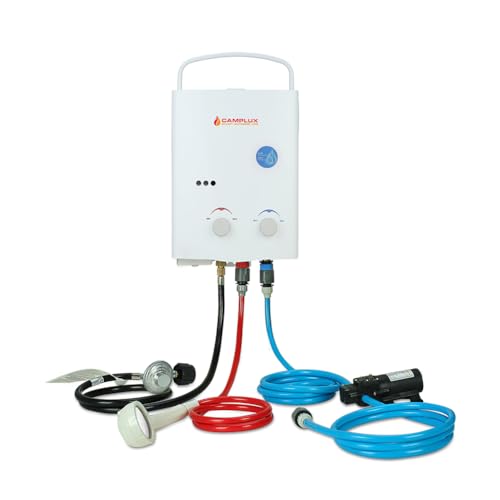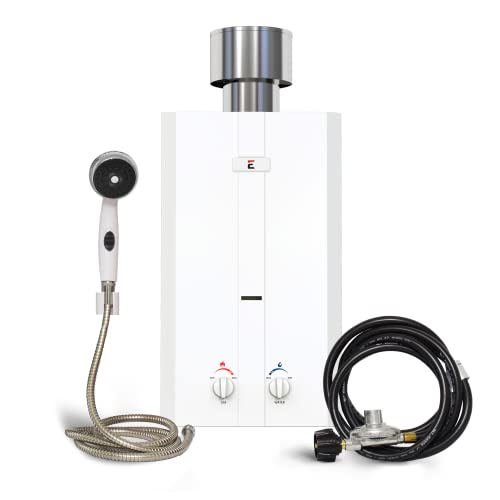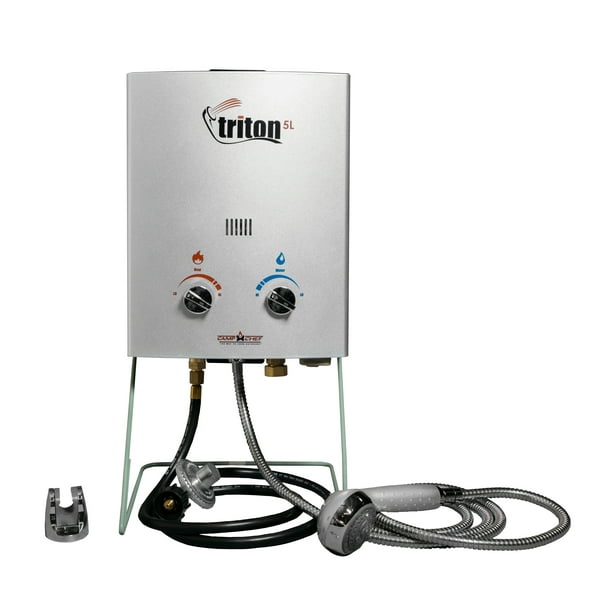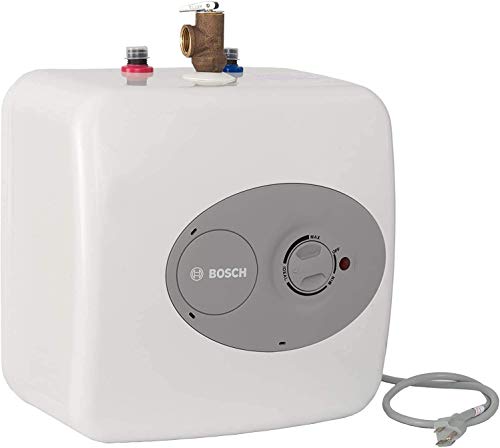Table of Contents
Running out of hot water after a long day could multiply your stress. Or imagine the horror of running out of cold water in the middle of winter. This is not at all impossible, as standard water heaters can only accommodate 6 to 10 gallons of water.
This is the reason why you have to choose a reliable and durable tankless water heater that can hold a good amount of liquid.
Tankless water heaters: our top recommendations
These are the units that passed and satisfied the considerations for a tankless water heater that we mentioned above.
Camplux 5L portable propane tankless water heater
This is one of the most portable and compact tankless water heaters out there. It can be used both outdoors and indoors as long as there is enough ventilation to avoid carbon dioxide toxicity.
With its foldable handle and propane fuel, you can carry it anywhere. You just need to include two D batteries for burner ignition. However, it cannot be used in a horizontal position, and draining it can be challenging as well.
Pros
- With a 2.5 psi starting pressure
- Easy to manipulate temperature
- With a fuel-efficient adjustable flow rate
- Heat and flow rates are controlled by two brass knobs
- Safe to use during winter with its freeze protection
- With top and bottom mounting brackets for ease of reach.
- Comes with hose, gas regulator, drain plug, and shower head
Cons
- Lacks thermostat monitor
- No batteries are included in the box
- Needs an adapter to fit NPT with its ½ inches BSP water line
- Continuous hot water is only up to 20 minutes but can be reset when turned off
- Not fit for use on high-elevated or with strong wind areas because burners die easily
Camplux 10L 2.64GMP outdoor portable tankless water heater
This is another propane-powered tankless water heater and is a bigger version compared to the Camplux model. For ignition, it requires two D batteries. It has a water line of ½” BSP and comes with an adapter to compensate for the non-standard NPT fitting.
Aside from the free adapter, you can also save more from its full/eco knob that helps you conserve and maximize propane usage.
Pros
- With a thermostat readout
- With a 3.6 psi starting pressure
- With an exhaust vent at the top
- Easy-to-access bottom screw holes
- Comes with a drain plug for ease of water removal
- Comes with a gas regulator, shower head, hose, and adapters
Cons
- Non-foldable handle
- Does not come with a rain cap
- Hard to reach top mounting bracket
- Needs a flue vent as it lacks space for back air circulation when mounted
- Continuous hot water is only up to 20 minutes but can be reset when turned off
Eccotemp L10 propane portable tankless water heater
This is another portable water heater that is best for outdoor use. It is fueled by propane, and just like the other water heaters mentioned, it needs two D batteries for ignition. It is portable and can easily be transported from one place to another through its mounting bracket. It runs only when you need it to, and that is its edge over the other products.
Pros
- With a gas regulator
- Can cater 20-lb propane or more
- Has a rain cap for added protection
- With the common Half inch NPT fitting
- Comes with an adapter and quick connects
- With a 20 psi starting pressure and a pressurized input
- Easy-to-reach screw holes at just ½ inch distance from the back
Cons
- Heavy
- Lacks handle
- Does not include batteries
- No temperature readout
- No freeze protection for winter use
- Does not have a shower head and hose
- Continuous hot water usage lasts only for 20 minutes
Excel propane tankless water heater
If you are looking for a well-designed tankless water heater that uses propane gas, this one suits you. Its edge, among other models, is that it does not give off flue gas since it uses technology from excel, which converts combustion to water vapor and monoxide.
Just like other propane models, it also requires two D-cell batteries. It has a 2 psi starting temperature.
Pros
- With a brass adaptor
- With a ½” standard NPT fitting
- The box includes batteries for immediate use
- It can work well at high altitudes as high as 7000 ft
- Has a wide range of water pressure from 2 to 120 psi
- Environmentally friendly with its Excel proprietary technology
Cons
- No freeze protection
- Installation can be hard
- Can only continuously work for 20 minutes
- Can have difficulty functioning at 50 degrees above
- Does not come with a shower head, hose, gas regulator and thermostat
- Needs to be set up in a well-ventilated place because the top can get extra hot
- The carbon monoxide it gives off can be dangerous at extreme levels, thus, requiring a detector.
EZ 202 portable propane tankless water heater
The same as the previous water heaters, this one also uses propane gas and requires two D-cell batteries for ignition. It is fuel efficient as it has a high flow rate of 3.2 gallons per minute, a higher one compared to other portable models.
In terms of fuel conservation, it has a winter/summer knob that enables propane usage limitations. The heater also automatically turns off once the temperature goes more than 88 degree Celsius or 190F.
Pros
- Uses ½” NPT fittings
- Steel-made gas inlet
- 2.9 psi starting pressure
- Has a thermostat readout
- Has a shower head and hose
- Has many vents for air passage
- Brass-made outlet fittings and water inlet
Cons
- Lacks gas regulator
- No rain cap included
- Does not include batteries
- Does not come with a handle
- Easily extinguished in windy areas
- Installation and set-up can be difficult due to hard-to-reach top mounting brackets.
Girard 2GWHAM propane tankless water heater
This is an all-rounder, fit for all-season use, and is a stronger, quieter, and more high-performing version than the 1GWHAF model. This propane-powered water heater does not need any special lines and has adaptors for brands like Suburban and Atwood.
However, it is not the ideal unit for portable use but is a reliable one for freezing weather. It also cannot go over 95 degrees.
Pros
- Self-regulating
- With freeze protection
- Requires a 12V power source
- With a ½” and ¾” water line and flare fitting, respectively
- Comes with a digital controller to remotely adjust the temperature
Cons
- Noisy cooling fan
- The cooling fan’s speed cannot be controlled
- Does not come with a mounting equipment
- Hot water continuously flows only for 20 minutes but can restart once turned off.
PrecisionTemp RV-550 tankless water heater
This small and light water heater is the winner in terms of efficiency. With just 1.2 the size and 1/3 the weight of an average 10-gallon water heater, it is capable enough to compete with its larger counterparts. It uses propane as fuel and also comes with adapter mounts for ease of adjustment to varying heater compartments.
If you are a fan of customization, you can choose between raw metal finish door or a standard white color or even have it personalized at an additional cost. Even with its hefty price, it gives value for your money.
Pros
- Does not produce a lot of noise
- With an automatic freeze protection
- Has a flow rate of 1.5 gallons per minute
- Unlimited continuous hot water, compared to other models’ 20 minutes
- With ½” and 3? 8” water line NPT fittings and gas line flare fitting, respectively
Cons
- Expensive
- No thermostat readout
- No valve for water input control
- Does not come with a controller
- Takes time to get continuous water flow
- It can be useless in areas with low and inconsistent water pressure
- It May shut down when used in very cold temperatures, such as in less than 38C.
Camp chef HWD5 triton water heater
Just like the other products mentioned, this also uses two D cell batteries along with its propane gas fuel. It has around 25 psi starting pressure with an 80 psi maximum pressure, inferior to that of other products. It comes with a garden house adapter, and one of its edges among the other models is that it can easily produce hot water right away.
Pros
- Has a stand
- Easy-to-reach screw holes
- ½” NPT fittings for water line
- With a big handle for ease of carrying
- Comes with a garden hose, shower head, and hose
Cons
- No gas regulator
- Lacks thermostat readout for monitoring
- Flames easily get extinguished in windy areas
- Does not have a drain plug for ease of draining and added winter protection
- The continuous flow of 20 minutes and will not restart after turning the unit off.
Bosch E34 Tronic 3000& electric water heater
This 13.65 x 13.5 x 13.75 inch Bosch mini electric tankless water heater is best for small RVs. Despite its size, it can handle 4 gallons of water. It has superior insulation and is resistant to corrosion because of its glass-lined tank interior.
Pros
- 3-foot-long power cord included
- Works in the standard 120-volt AC outlet
- Has a temperature-and-pressure relief valve
- With an external control dial for accurately changing temperatures
Cons
- Electric element life may be short due to the small size
The Complete Guide to Understanding RV Tankless Water Heaters
If you’ve ever run out of hot water during a refreshing shower in your RV, you know it’s not the most pleasant experience. Tankless water heaters for RVs are increasingly popular solutions for this inconvenience. But how do they work, and are they worth the investment? This comprehensive guide gives you the insights you need to make an informed decision. With years of experience in the industry and careful evaluation of available options, let’s explore the ins and outs of tankless water heaters for RVs.
How Does a Tankless Water Heater Work?
In simple terms, a tankless water heater heats water on demand as it flows through the unit. Unlike traditional water heaters that store hot water in a tank, tankless systems eliminate the need for constant refilling and reheating. These heaters typically use propane or electricity and require a 12-volt DC power supply in your RV.
Types of RV Tankless Water Heaters
Gas Water Heater
Gas-powered heaters use propane or kerosene and require adequate ventilation due to the potential health risks of gas fumes. Although cheaper and about 85% efficient, they are less environmentally friendly as they emit greenhouse gases.
Electric Water Heater
Electric models are eco-friendly and can easily be hooked up to a solar panel or generator. With a 99% efficiency rate—although it may vary for short bursts like hand washing—these units are easy to install and cost-effective in the long run.
Condensing Water Heater
Condensing units boast 92-94% energy efficiency and use a secondary heat exchanger to recycle exhaust heat. While less efficient than other types, they are generally less expensive.
Non-Condensing Water Heater
These heaters use a single heat exchanger and stainless steel exhaust vents. They may incur additional costs for the ventilation system but are known for their durability and longevity.
Is Investing in a Tankless Water Heater Worthwhile?
Pros
- Longevity: Lasts 5-10 years longer than traditional heaters
- Tax Benefits: Some states offer tax credits or rebates
- Low Maintenance: Reduced repair costs
- Compact: No need for a storage tank, making it ideal for smaller RVs
- Energy Efficient: Saves about 8-14% of energy, according to Energy.gov
Cons
- Fluctuating water temperature
- Higher initial cost
- Risk of water wastage if not installed correctly
Factors to Consider Before Buying
Size and Space
Make sure the unit you select fits your available space and complements your existing setup. The average unit can supply 2-6 gallons of hot water per minute, so consider your usage accordingly.
BTU (British Thermal Unit)
Higher BTU ratings indicate faster heating capabilities. Most models range from 30,000 to 50,000 BTUs per hour.
Flow Rate and Water Pressure
Check the flow rate (GPM) and water pressure (PSI) specifications on the product labels to ensure compatibility with your RV’s plumbing system.
Price and Brand
Prices range from $200 to $1,000, with features and capacities varying accordingly. Trusted brands in this sector include Atwood, Girard, and Suburban.
Leading Brands to Consider
- Takagi: Known for its high-quality products, Takagi has been around since 1952 and has a global presence.
- Suburban: A household name since 1947, they offer a range of efficient and reliable water heaters.
- Excel: This Florida-based company is known for its gasFlex flexible gas piping system and tankless water heaters.
- The Girard Group: They launched the first RV tankless water heater in 2009 and continue to lead in this sector.
How to Use Your Tankless Water Heater
The installation process varies depending on the model and space constraints. If you’re not comfortable doing it yourself, it’s advisable to seek professional help. Once installed, follow these steps for proper operation:
- Open the bypass valve and let water flow into the primary tank.
- Connect your RV to a water source.
- Begin pumping water using an onboard pump.
- Turn on the hot water tap to initiate the heating process.
Frequently Asked Questions
Can I convert my RV’s traditional heater to a tankless system?
Yes, but consult a professional for a proper installation plan.
Can I install the heater under a sink?
As long as you adhere to manufacturer guidelines, it should be fine.
Why is the faucet water cooler than the control panel indicates?
Some temperature drop is normal as water moves further from the heater.
Do I need a separate water pump?
This depends on your specific RV setup and the water heater model you choose.
Conclusion
Choosing a tankless water heater for your RV is an important decision that requires careful consideration of various factors. If you’re not mechanically inclined, it’s wise to seek professional help for both selection and installation. Despite their initial cost, the long-term benefits often outweigh the disadvantages. So, if you’re tired of taking icy showers or running out of hot water on your RV journeys, a tankless water heater might just be the solution you’ve been seeking.









